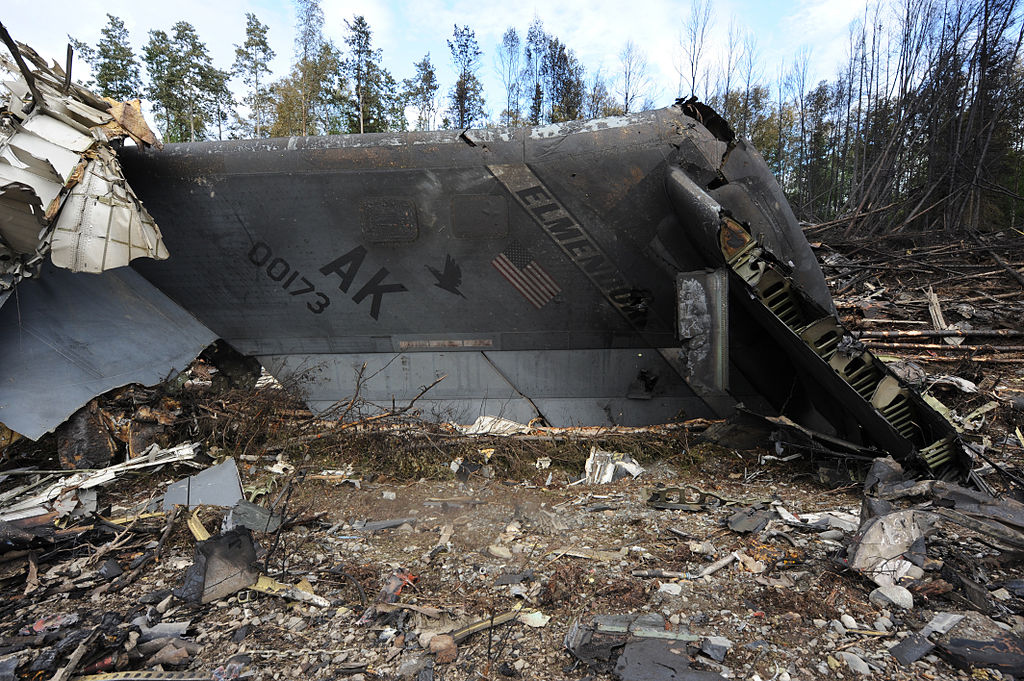In 2018 ‘Sitka 43’ C-17 Globemaster III wreckage found a new purpose at the Air Force Safety Center (AFSEC) Crash Lab at Kirtland Air Force Base, N.M.
Taken on Jul. 28, 2010, at Joint Base Elmendorf- Richardson (JBER), the sad video in this post shows C-17 Globemaster III – tail number 00-0173 and call sign Sitka 43 belonging to the 3rd Wing and operated jointly with the 176th Wing – crashing while practicing for the Arctic Thunder Air Show.
Officials at Headquarters Pacific Air Forces released the results of their investigation into the fatal crash on Dec. 10 of the same year.
Gen. Gary North, then Pacific Air Forces commander, directed an investigation into the incident which resulted in the deaths of the four crewmembers aboard, the destruction of the $184 million aircraft, and damage to part of the Alaska Railroad.
The accident investigation board found clear and convincing evidence the cause of the mishap was a pilot error. The investigation revealed the pilot placed the aircraft outside established flight parameters and capabilities. During the mishap sortie, the pilot aggressively flew the aircraft in a manner inconsistent with established flight procedures, resulting in a stall. The pilot failed to take the required stall recovery actions.
Furthermore, the board concluded the co-pilot and safety observer failed to recognize or address the developing dangerous situation. As a result, the C-17 stalled at an attitude and altitude from which recovery to controlled flight was impossible.

As told by Airman 1st Class Crystal A. Jenkins, JBER Public Affairs, in the article Sitka 43 continues to serve eight years after the fatal crash, in 2017 a team of Airmen from various units assembled with the sole mission of removing the wreckage that had been stored at JBER since 2010.
After multiple shipments and combined efforts of many units including the 773d and 673d logistics readiness squadrons, at the end of September 2018 found the ‘Sitka 43’ wreckage found a new purpose at the Air Force Safety Center Crash Lab at Kirtland Air ForcenBase, New Mexico.
AFSEC’s mission is to safeguard Airmen, protect resources, and preserve combat capability. The goal is to develop skilled investigators who will be able to identify factors, analyze findings and develop recommendations that will prevent future Air Force mishaps.
“The lab is a 29-acre site used as a hands-on training facility,” said Gwendolyn Dooley, Chief, AFSEC Training and Force Development. “The wreckage will be laid out to duplicate the original mishap in both scale and investigative clues. Additionally, course material will be revised to incorporate a mishap investigation lab utilizing the C-17 wreckage.”
This addition expands the curriculum at AFSEC by providing students with a modernized hands-on lab for heavy aircraft during the Aircraft Mishap Investigation Course.
“The C-17 is the first heavy cargo aircraft to be placed at the crash lab,” said Lt. Col. Rich Couture, Deputy DivisionnChief, AFSEC Training, and Force Development. “This will enhance student learning by enabling them to see and actually touch the debris while applying investigative techniques during their lab.”

During the classroom-based portion of the mishap investigation course students are provided data from the original mishap, then proceed to the crash lab to apply what they’ve learned.”
We believe this blended learning approach will enhance the student’s ability to investigate mishaps while also enhancing the Air Force’s ability to fly, fight and win — in air, space and cyberspace, Couture said.
Although the wreckage will benefit future Airmen at AFSEC, the team assembled at JBER has also been impacted.
“When I was first told that I was going to be a part of the C-17 wreckage disposal team, I saw it as another project,” said U.S. Air Force Master Sgt. April Godbolt, wreckage disposal team member and Section Chief for the Customer Support 673d Logistics Readiness Squadron.n“I felt this way until I set foot in the actual yard. Immediately my entire demeanor shifted. I felt such a somber feeling, realizing the great loss of life that had occurred here.
“It was from that moment I knew this was more than just disposing of a destroyed aircraft, but rather my responsibility to remove it for the sake of the Airmen and for the families who had suffered the loss of their loved ones. I have counted it an honor and a privilege to be a part of something that has and will continue to have an impact on the lives and hearts of so many.”
Four Airmen ( Majors Michael Freyholtz and Aaron Malone, pilots assigned to the Alaska Air National Guard’s 249th Airlift Squadron; Captain Jeffrey Hill, a pilot assigned to Elmendorf’s active-duty Air Force’s 517th Airlift Squadron; and Senior Master Sergeant Thomas E. Cicardo, a loadmaster of the Alaska Air National Guard’s 249th Airlift Squadron) were lost on Jul. 28, 2010, and their memories live on through the individuals stationed at Joint Base Elmendorf-Richardson.
Photo by Senior Airman Cynthia Spalding/JBER PAO / U.S. Air Force

